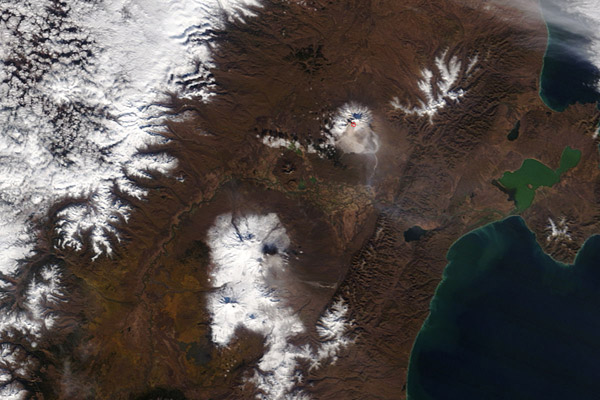Images
October 10, 2016 - Activity at Shiveluch and Kliuchevskoi, Kamchatka Peninsula
Tweet
On October 7, 2016, the Moderate Resolution Imaging Spectroradiometer (MODIS) flying aboard NASA’s Terra satellite captured a true-color image of ash plumes rising from two of Kamchatka’s most active volcanoes.
In the north a large ash plume rises from Shiveluch Volcano, one of the largest and most active volcanoes on the Kamchatka Peninsula. Rising to 3,283 meters (10,771 feet) above sea level, Shiveluch is a stratovolcano composed of alternating layers of hardened lava, compacted ash, and rocks ejected by previous eruptions. The typical eruptive style of the volcano is highly explosive, often forming domes of lava and shooting lava and ash high into the air.
A major partial dome collapse was reported to have occurred on September 19, with a large lava flow that extended more than 10 km (6 miles). The red hotspot on the summit marks an area where the thermal bands on the instrument detected an area warmer than background – in this case mostly likely marking the lava flow.
Kliuchevsky (also known as Klyuchevskoy) is Kamchatka’s highest volcano, is a symmetrical, 4,835 meter (15,863 feet) high basaltic stratovolcano. It is also one of the world’s most active volcanoes, with frequent effusive and explosive eruptions with only short quiescence periods. Situated south of Shiveluch, and covered with snow, gray volcanic ash rises nearly straight upward before blowing towards the southeast.
Image Facts
Satellite:
Terra
Date Acquired: 10/7/2016
Resolutions:
1km (32.5 KB), 500m (75.3 KB), 250m (195.3 KB)
Bands Used: 1,4,3
Image Credit:
Jeff Schmaltz, MODIS Land Rapid Response Team, NASA GSFC
Tweet
On October 7, 2016, the Moderate Resolution Imaging Spectroradiometer (MODIS) flying aboard NASA’s Terra satellite captured a true-color image of ash plumes rising from two of Kamchatka’s most active volcanoes.
In the north a large ash plume rises from Shiveluch Volcano, one of the largest and most active volcanoes on the Kamchatka Peninsula. Rising to 3,283 meters (10,771 feet) above sea level, Shiveluch is a stratovolcano composed of alternating layers of hardened lava, compacted ash, and rocks ejected by previous eruptions. The typical eruptive style of the volcano is highly explosive, often forming domes of lava and shooting lava and ash high into the air.
A major partial dome collapse was reported to have occurred on September 19, with a large lava flow that extended more than 10 km (6 miles). The red hotspot on the summit marks an area where the thermal bands on the instrument detected an area warmer than background – in this case mostly likely marking the lava flow.
Kliuchevsky (also known as Klyuchevskoy) is Kamchatka’s highest volcano, is a symmetrical, 4,835 meter (15,863 feet) high basaltic stratovolcano. It is also one of the world’s most active volcanoes, with frequent effusive and explosive eruptions with only short quiescence periods. Situated south of Shiveluch, and covered with snow, gray volcanic ash rises nearly straight upward before blowing towards the southeast.
Image Facts
Satellite:
Terra
Date Acquired: 10/7/2016
Resolutions:
1km (32.5 KB), 500m (75.3 KB), 250m (195.3 KB)
Bands Used: 1,4,3
Image Credit:
Jeff Schmaltz, MODIS Land Rapid Response Team, NASA GSFC




